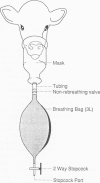Abstract
In preliminary studies feeding the poorly absorbed carbohydrate sorbitol at 2.3 g/kg body weight as an indication of maximal fermentative capacity failed to produce the expected large increase in breath hydrogen excretion but did produce a transient diarrhea in five out of six control calves. Twelve healthy control and eighteen diarrheic calves were fed lactose or D-xylose on consecutive days at 1.15 g/kg body weight and a concentration of 46 g/L. Breath and blood samples were collected at 1 h intervals from 0 to 7 h. After administration of lactose, there was a significant increase in breath hydrogen excretion in diarrheic versus control calves. The increase in plasma glucose concentrations was delayed in diarrheic calves but the area under the absorption curve was similar in control and diarrheic calves. After administration of D-xylose, breath hydrogen excretion did not increase significantly but plasma D-xylose concentrations were significantly reduced in diarrheic calves. The pathogens commonly isolated from the feces were Cryptosporidium species, rotavirus and coronavirus. The number of pathogens and the severity of the calves' acid-base deficit were not related to the severity of carbohydrate malabsorption. Decreased absorption of lactose and D-xylose may be the result of intestinal villous atrophy caused by viral or parasite infection. It was concluded that carbohydrate malabsorption rather than a specific lactose maldigestion is a significant problem in diarrheic calves. Diarrheic calves appear to digest and absorb lactose when fed in small amounts.
Full text
PDF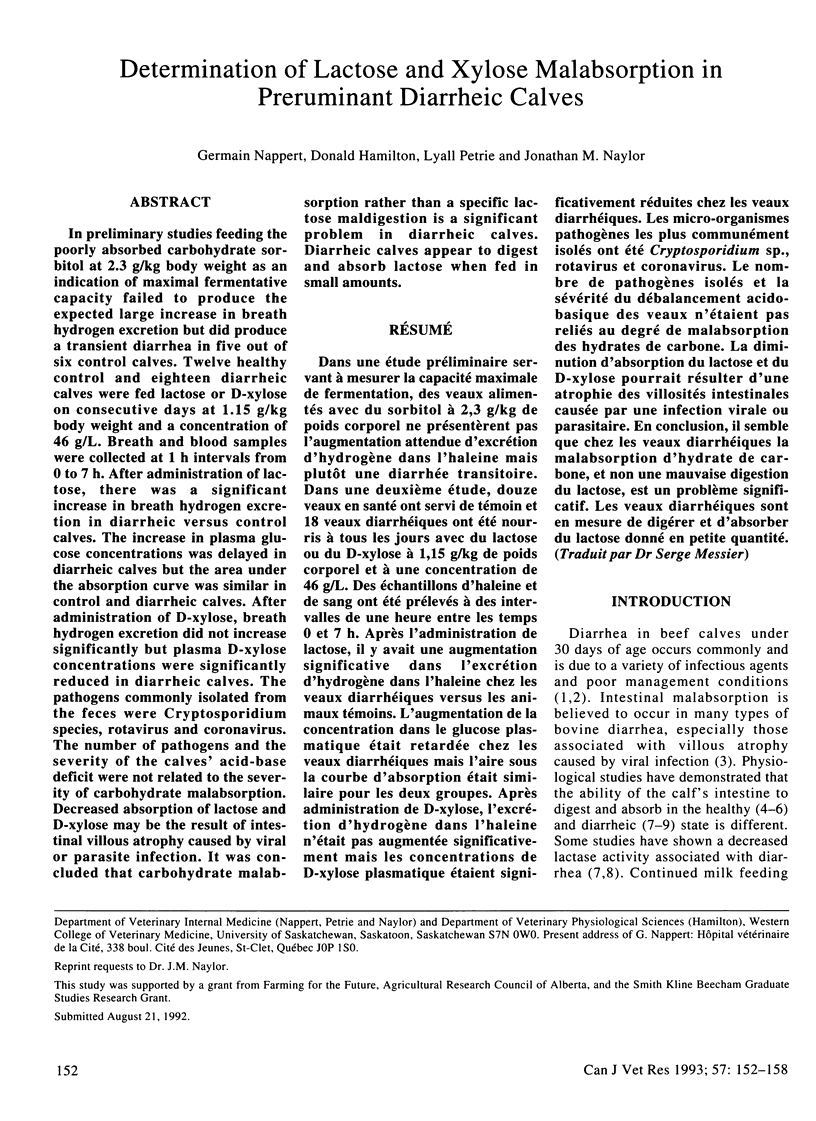

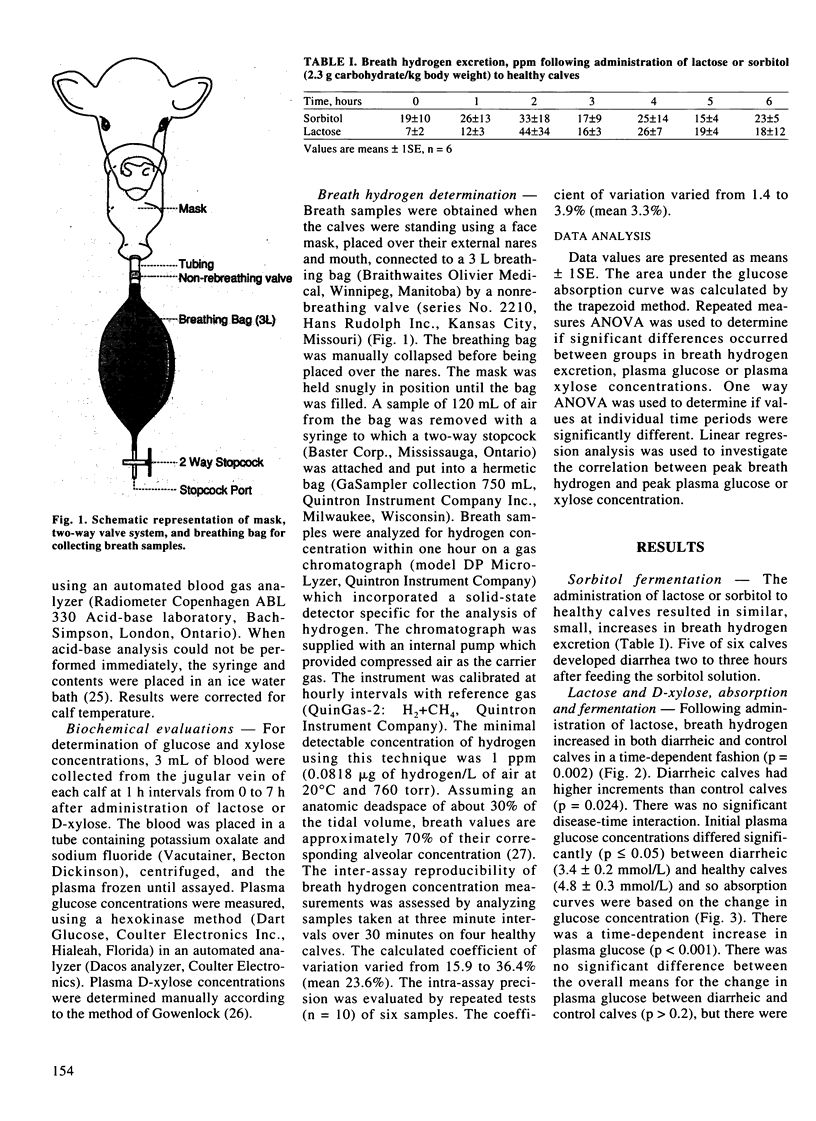
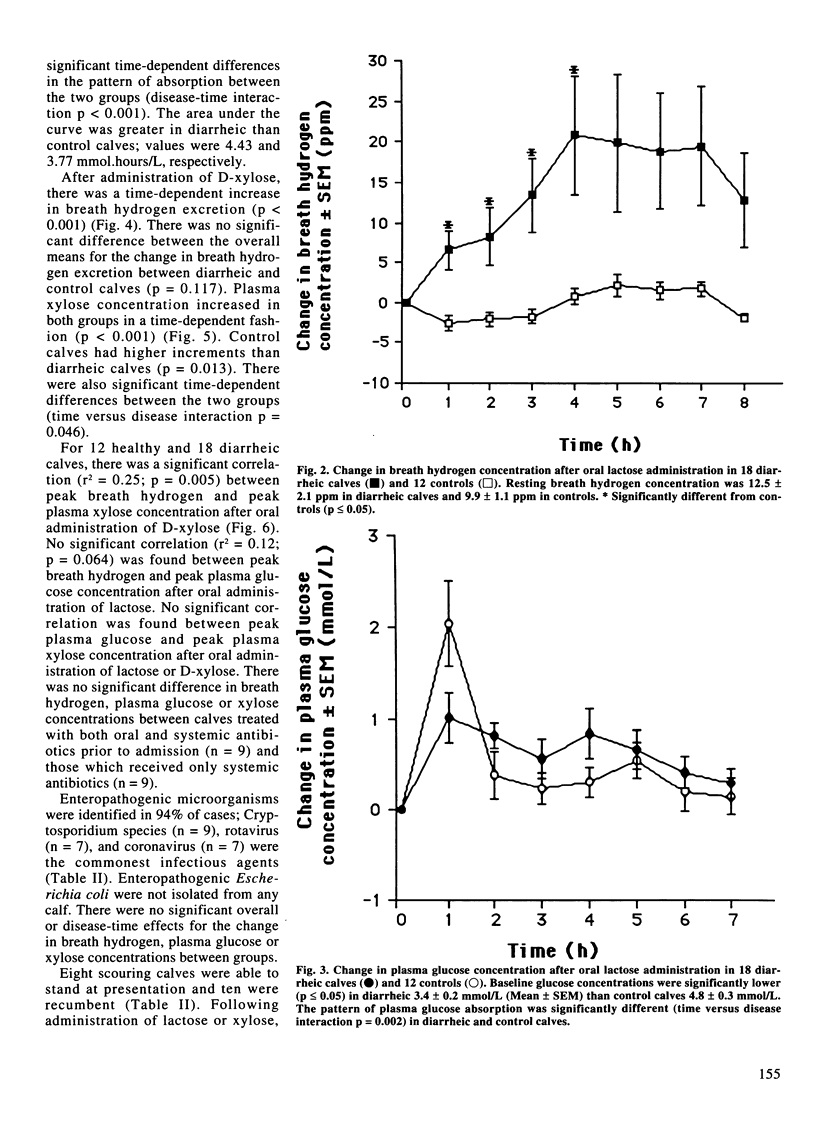
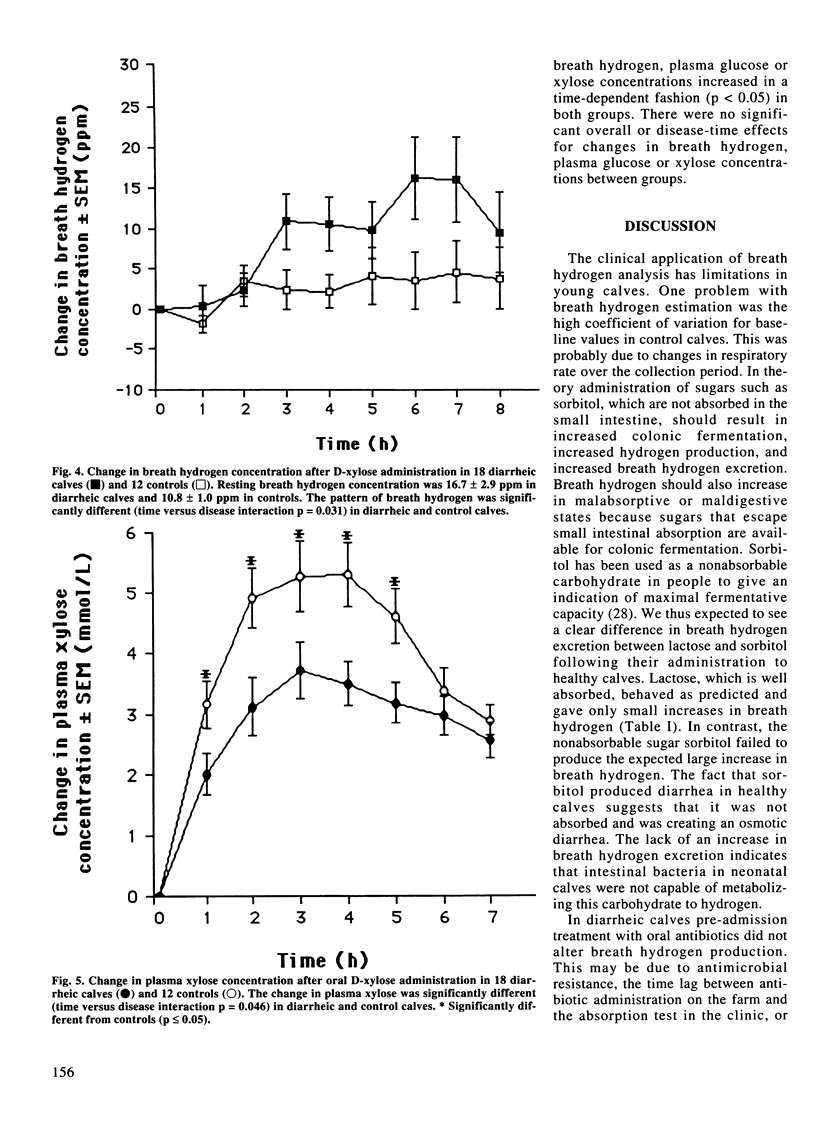
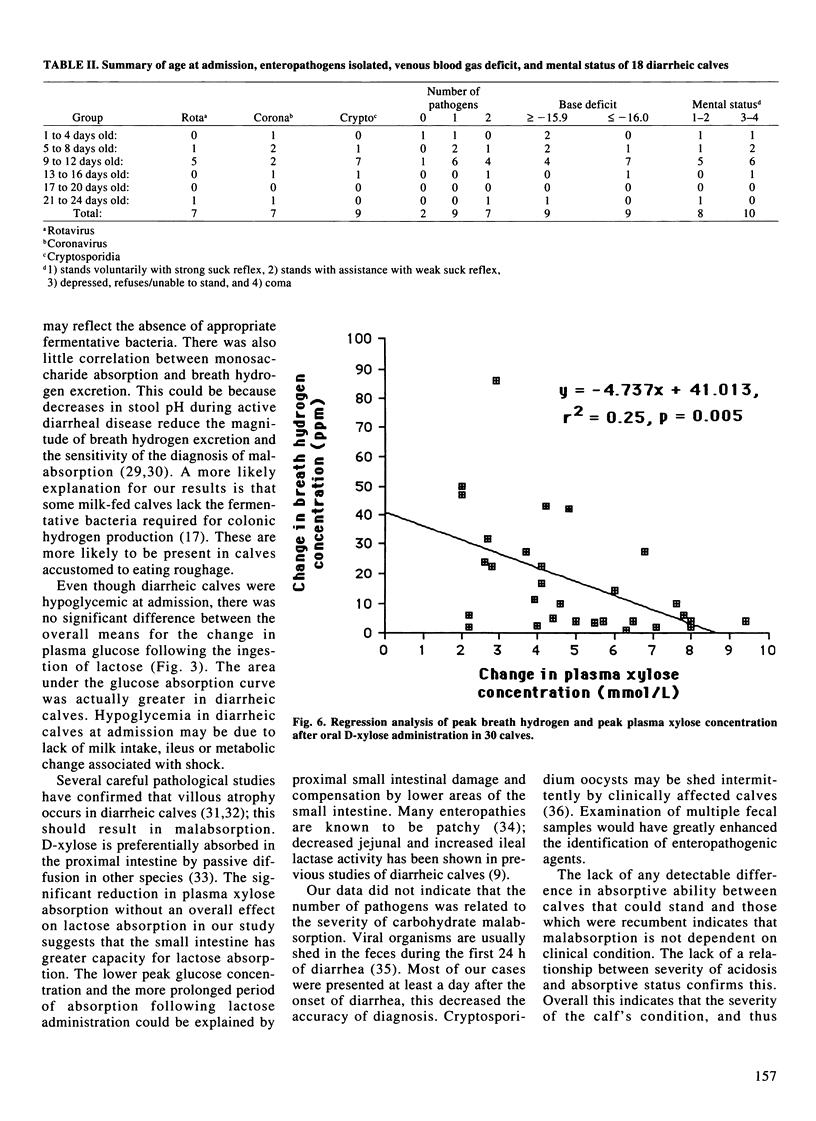
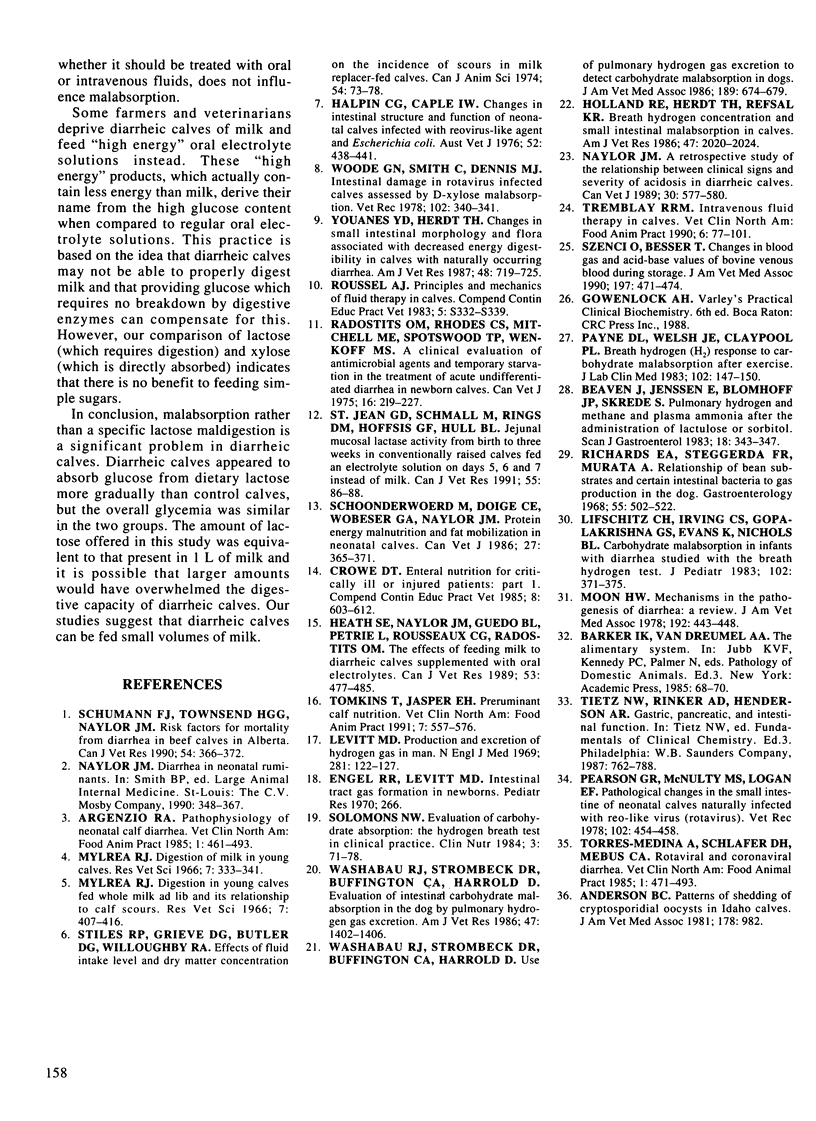
Images in this article
Selected References
These references are in PubMed. This may not be the complete list of references from this article.
- Anderson B. C. Patterns of shedding of cryptosporidial oocysts in Idaho calves. J Am Vet Med Assoc. 1981 May 1;178(9):982–984. [PubMed] [Google Scholar]
- Argenzio R. A. Pathophysiology of neonatal calf diarrhea. Vet Clin North Am Food Anim Pract. 1985 Nov;1(3):461–469. doi: 10.1016/s0749-0720(15)31296-2. [DOI] [PubMed] [Google Scholar]
- Beaven J., Bjørneklett A., Jenssen E., Blomhoff J. P., Skrede S. Pulmonary hydrogen and methane and plasma ammonia after the administration of lactulose or sorbitol. Scand J Gastroenterol. 1983 May;18(3):343–347. doi: 10.3109/00365528309181604. [DOI] [PubMed] [Google Scholar]
- Halpin C. G., Caple I. W. Changes in intestinal structure and function of neonatal calves infected with reovirus-like agent and Eschericia coli. Aust Vet J. 1976 Oct;52(10):438–441. doi: 10.1111/j.1751-0813.1976.tb05384.x. [DOI] [PubMed] [Google Scholar]
- Heath S. E., Naylor J. M., Guedo B. L., Petrie L., Rousseaux C. G., Radostits O. M. The effects of feeding milk to diarrheic calves supplemented with oral electrolytes. Can J Vet Res. 1989 Oct;53(4):477–485. [PMC free article] [PubMed] [Google Scholar]
- Holland R. E., Herdt T. H., Refsal K. R. Breath hydrogen concentration and small intestinal malabsorption in calves. Am J Vet Res. 1986 Sep;47(9):2020–2024. [PubMed] [Google Scholar]
- Levitt M. D. Production and excretion of hydrogen gas in man. N Engl J Med. 1969 Jul 17;281(3):122–127. doi: 10.1056/NEJM196907172810303. [DOI] [PubMed] [Google Scholar]
- Lifschitz C. H., Irving C. S., Gopalakrishna G. S., Evans K., Nichols B. L. Carbohydrate malabsorption in infants with diarrhea studied with the breath hydrogen test. J Pediatr. 1983 Mar;102(3):371–375. doi: 10.1016/s0022-3476(83)80651-9. [DOI] [PubMed] [Google Scholar]
- Moon H. W. Mechanisms in the pathogenesis of diarrhea: a review. J Am Vet Med Assoc. 1978 Feb 15;172(4):443–448. [PubMed] [Google Scholar]
- Mylrea P. J. Digestion in young calves fed whole milk ad lib. and its relationship to calf scours. Res Vet Sci. 1966 Oct;7(4):407–416. [PubMed] [Google Scholar]
- Mylrea P. J. Digestion of milk in young calves. I. Flow and acidity of the contents of the small intestine. Res Vet Sci. 1966 Jul;7(3):333–341. [PubMed] [Google Scholar]
- Naylor J. M. A retrospective study of the relationship between clinical signs and severity of acidosis in diarrheic calves. Can Vet J. 1989 Jul;30(7):577–580. [PMC free article] [PubMed] [Google Scholar]
- Payne D. L., Welsh J. D., Claypool P. L. Breath hydrogen (H2) response to carbohydrate malabsorption after exercise. J Lab Clin Med. 1983 Jul;102(1):147–150. [PubMed] [Google Scholar]
- Pearson G. R., McNulty M. S., Logan E. F. Pathological changes in the small intestine of neonatal calves naturally infected with reo-like virus (rotavirus). Vet Rec. 1978 May 27;102(21):454–458. doi: 10.1136/vr.102.21.454. [DOI] [PubMed] [Google Scholar]
- Radostits O. M., Rhodes C. S., Mitchell M. E., Spotswood T. P., Wenkoff M. S. A clinical evaluation of antimicrobial agents and temporary starvation in the treatment of acute undifferentiated diarrhea in newborn calves. Can Vet J. 1975 Aug;16(8):219–227. [PMC free article] [PubMed] [Google Scholar]
- Richards E. A., Steggerda F. R., Murata A. Relationship of bean substrates and certain intestinal bacteria to gas production in the dog. Gastroenterology. 1968 Oct;55(4):502–509. [PubMed] [Google Scholar]
- Schoonderwoerd M., Doige C. E., Wobeser G. A., Naylor J. M. Protein energy malnutrition and fat mobilization in neonatal calves. Can Vet J. 1986 Oct;27(10):365–371. [PMC free article] [PubMed] [Google Scholar]
- Schumann F. J., Townsend H. G., Naylor J. M. Risk factors for mortality from diarrhea in beef calves in Alberta. Can J Vet Res. 1990 Jun;54(3):366–372. [PMC free article] [PubMed] [Google Scholar]
- St Jean G. D., Schmall L. M., Rings D. M., Hoffsis G. F., Hull B. L. Jejunal mucosal lactase activity from birth to three weeks in conventionally raised calves fed an electrolyte solution on days 5, 6 and 7 instead of milk. Can J Vet Res. 1991 Jan;55(1):86–88. [PMC free article] [PubMed] [Google Scholar]
- Szenci O., Besser T. Changes in blood gas and acid-base values of bovine venous blood during storage. J Am Vet Med Assoc. 1990 Aug 15;197(4):471–474. [PubMed] [Google Scholar]
- Tomkins T., Jaster E. H. Preruminant calf nutrition. Vet Clin North Am Food Anim Pract. 1991 Jul;7(2):557–576. [PubMed] [Google Scholar]
- Torres-Medina A., Schlafer D. H., Mebus C. A. Rotaviral and coronaviral diarrhea. Vet Clin North Am Food Anim Pract. 1985 Nov;1(3):471–493. doi: 10.1016/S0749-0720(15)31297-4. [DOI] [PMC free article] [PubMed] [Google Scholar]
- Tremblay R. R. Intravenous fluid therapy in calves. Vet Clin North Am Food Anim Pract. 1990 Mar;6(1):77–101. doi: 10.1016/S0749-0720(15)30896-3. [DOI] [PMC free article] [PubMed] [Google Scholar]
- Washabau R. J., Strombeck D. R., Buffington C. A., Harrold D. Evaluation of intestinal carbohydrate malabsorption in the dog by pulmonary hydrogen gas excretion. Am J Vet Res. 1986 Jun;47(6):1402–1406. [PubMed] [Google Scholar]
- Washabau R. J., Strombeck D. R., Buffington C. A., Harrold D. Use of pulmonary hydrogen gas excretion to detect carbohydrate malabsorption in dogs. J Am Vet Med Assoc. 1986 Sep 15;189(6):674–679. [PubMed] [Google Scholar]
- Woode G. N., Smith C., Dennis M. J. Intestinal damage in rotavirus infected calves assessed by D-xylose malabsorption. Vet Rec. 1978 Apr 15;102(15):340–341. doi: 10.1136/vr.102.15.340-a. [DOI] [PubMed] [Google Scholar]
- Youanes Y. D., Herdt T. H. Changes in small intestinal morphology and flora associated with decreased energy digestibility in calves with naturally occurring diarrhea. Am J Vet Res. 1987 Apr;48(4):719–725. [PubMed] [Google Scholar]



